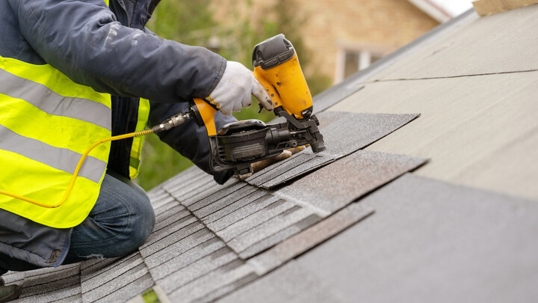The Best Time to Replace Your Roof
Ever find yourself staring up at your roof, maybe after a nasty storm or just noticing some wear and tear, and that big question pops into your head: "Okay, when on earth is the best time to actually replace my roof?"
You're not alone! It's a big decision. Timing can impact everything from how smoothly the project goes to the longevity of your new roof. A reputable local roofer should advise on the best time to replace your roof, so be sure to get a few inspections and estimates.
However, we'll dive into some general considerations so you can be confident knowing when is the ideal time to replace your roof.
When is the Best Time to Replace Your Roof?
For a lot of folks across the country, spring and fall tend to be the sweet spots for getting a new roof installed.
Here's why spring and fall are the best seasons for roof replacement:
- Temperature's Just Right. Warmer temperatures are often ideal for shingles to adhere and seal, ensuring a long-lasting bond. Shingles won't bond properly in cold weather.
- Drier Days are Your Friends. Generally, spring and fall bring more predictable and drier weather in many regions. Fewer rain delays mean a faster, smoother installation process.
- Preparing for Harsh Weather. Late spring sets you up perfectly to handle those potentially stormy summer months with a brand-spankin' new roof. And a fall replacement ensures you're all buttoned up and protected before winter's harsh conditions roll in.
What if you need a new roof outside of the ideal window? A good roofer can install a new roof year-round if it's an emergency. They can find creative ways to get the job done in extreme weather. When there’s a will, there’s a way. Or, they should offer a roof repair option and replace it in more ideal conditions.
Roof Replacement Guidelines for Each Region
However, the vast and varied climate of the United States means that the ideal window can shift depending on where you live.
Below are several recommendations based on the key regions throughout the country:
- The Northeast. Late spring and early fall are your best picks. You'll get those moderate temps without the heavy spring rains or the looming threat of early snowstorms.
- The Southeast. Spring often takes the crown here. You'll beat the intense summer heat and the peak of hurricane season.
- The Southwest. Spring and fall are your go-to seasons to dodge the scorching summer and the monsoon season.
- The Pacific Northwest. Late spring, summer, and early fall offer the driest and mildest stretches. Summer is usually the most predictable, but those spring and fall seasons can be great, too.
- The Midwest. Late spring and summer are generally favored because of the warmer temperatures that help those shingles seal tightly. Just keep an eye on the forecast for those summer thunderstorms!
Disclaimer: Keep in mind, these are general guidelines! The absolute best time for your roof replacement can depend on the specific weather patterns in your local area. That's why getting a trusted, local roofer's advice is always best.
Weighing the Pros and Cons of Roofing in Different Weather
So, what are the potential upsides and downsides of installing a roof in warm vs. cool weather? Continue reading to find out.
Warm Weather (Late Spring, Summer, Early Fall)
Pros
- Optimal Shingle Adhesion. Asphalt shingles properly adhere to each other during warm weather. The seal creates a watertight seal that is essential for preventing premature failure.
- Longer Daylight Hours. More daylight means roofing crews have more time to work, potentially leading to a quicker install.
Cons
- Material Handling Challenges in Extreme Heat. Some roofing materials can become too soft or sticky in intense heat, making them difficult to handle and install correctly.
- Increased Risk of Summer Storms. Depending on your region, summer can bring unpredictable thunderstorms. Such storms can halt work and potentially damage an exposed roof deck.
- Peak Season Demand. Warmer months are often the busiest for roofing contractors. Some roofers may charge more since there's more demand during warmer months.
Cold Weather (Late Fall, Winter, Early Spring)
Pros
- Potentially Faster Scheduling. Late fall and winter can be slower periods for roofing contractors. potentially offering more flexible scheduling and quicker project starts.
- Potentially More Cost-Effective Estimates. Some contractors might offer off-season discounts or reduce prices since there’s less demand.
Cons
- Poor Shingle Adhesion. Cold temperatures can prevent asphalt shingles from softening and bonding. A weaker seal can lead to a less secure and watertight roof, increasing the risk of wind damage. Special installation techniques and hand-sealing might be required.
- Shorter Daylight Hours. Less daylight restricts the amount of work that can be done in a day, potentially prolonging the project timeline.
- Potential for Weather Delays. Winter weather can cause unpredictable delays.
Truth Be Told...Roofers Can Roof Year-Round
Ultimately, late spring and early fall often offer the most favorable conditions for roof replacement in many areas. Understanding your local climate and the potential challenges of other seasons is crucial. When in doubt, call a reputable roofing company for an inspection.
A good roofing contractor should be able to install your roof year-round. Weather, roofing materials, and time of year will factor in scheduling and cost. But a great roofer can problem-solve their way through your project so you can get a new roof when you need it.
When in doubt, call a local roofer for an inspection and estimate! At Might Dog Roofing, we provide residential and commercial roofing services in parts of the country. You can visit our Locations page to find your local Mighty Dog Roofing and book a free inspection.


